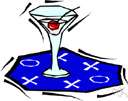Man·hat·tan 1
(măn-hăt′n, mən-)1. A borough of New York City in southeast New York, mainly on Manhattan Island at the north end of New York Bay. Peter Minuit of the Dutch West Indies Company bought the island in 1626 from the Manhattan Indians, supposedly for $24 worth of merchandise. The settlement of New Amsterdam, renamed New York when the English assumed control in 1664, quickly spread from the southern tip of the island, eventually becoming the financial and commercial center of the United States.
2. A city of northeast Kansas west of Topeka. It is the seat of Kansas State University (established 1863).
Man·hat′tan·ite′ (-īt′) n.
Man·hat·tan 2
also man·hat·tan (măn-hăt′n, mən-)n.
A cocktail made of sweet vermouth, whiskey, and a dash of bitters.
[After Manhattan1a borough of New York City.]
American Heritage® Dictionary of the English Language, Fifth Edition. Copyright © 2016 by Houghton Mifflin Harcourt Publishing Company. Published by Houghton Mifflin Harcourt Publishing Company. All rights reserved.
Manhattan
(mænˈhætən; mən-)n
1. (Placename) an island at the N end of New York Bay, between the Hudson, East, and Harlem Rivers: administratively (with adjacent islets) a borough of New York City; a major financial, commercial, and cultural centre. Pop: 1 537 195 (2000). Area: 47 sq km (22 sq miles)
2. (Brewing) a mixed drink consisting of four parts whisky, one part vermouth, and a dash of bitters
Collins English Dictionary – Complete and Unabridged, 12th Edition 2014 © HarperCollins Publishers 1991, 1994, 1998, 2000, 2003, 2006, 2007, 2009, 2011, 2014
Man•hat•tan
(mænˈhæt n, mən-)n.
1. Also called Manhat′tan Is′land. an island in New York City surrounded by the Hudson, East, and Harlem rivers. 13½ mi. (22 km) long.
2. a borough of New York City approximately coextensive with Manhattan Island. 1,427,533.
3. (often l.c.) a cocktail of rye, vermouth, and bitters.
Man•hat′tan•ite`, n.
Random House Kernerman Webster's College Dictionary, © 2010 K Dictionaries Ltd. Copyright 2005, 1997, 1991 by Random House, Inc. All rights reserved.
ThesaurusAntonymsRelated WordsSynonymsLegend:
| Noun | 1. |  Manhattan - one of the five boroughs of New York City Manhattan - one of the five boroughs of New York CityGreater New York, New York, New York City - the largest city in New York State and in the United States; located in southeastern New York at the mouth of the Hudson river; a major financial and cultural center Fifth Avenue - an avenue in Manhattan that separates the east side of Manhattan from the west side Seventh Avenue - an avenue in Manhattan that runs north and south Central Park - a large park in Manhattan Harlem - a district of Manhattan; now largely a Black ghetto Hell's Half Acre, Hell's Kitchen - a district in Manhattan formerly noted for its slums and vice SoHo, South of Houston - a district in southwestern Manhattan noted for its shops and restaurants and galleries and artist's lofts Bowery - a street in Manhattan noted for cheap hotels frequented by homeless derelicts Broadway, Great White Way - a street in Manhattan that passes through Times Square; famous for its theaters Park Ave., Park Avenue - a fashionable residential street in New York City off-Broadway - low-budget theaters located outside the Broadway area in Manhattan Times Square - the area of Manhattan around the intersection of Broadway and Seventh Avenue; heart of the New York theater district; site of annual celebration of New Year's Wall St., Wall Street - a street in lower Manhattan where the New York Stock Exchange is located; symbol of American finance |
| 2. |  manhattan - a cocktail made with whiskey and sweet vermouth with a dash of bitters manhattan - a cocktail made with whiskey and sweet vermouth with a dash of bittersItalian vermouth, sweet vermouth - sweet dark amber variety cocktail - a short mixed drink Rob Roy - a manhattan cocktail made with Scotch whiskey |
Based on WordNet 3.0, Farlex clipart collection. © 2003-2012 Princeton University, Farlex Inc.